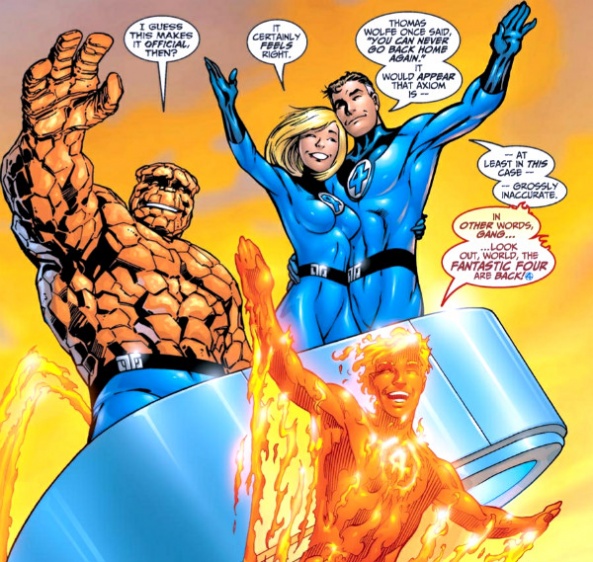From the Files of the Baxter Building comes Multiversity’s monthly deep dive into the comics and characters that inhabit the world of the First Family of superhero comics: The Fantastic Four!
This month: The World’s Greatest Comic Magazine makes a comeback, the Impossible Man gets all meta, we take a look at all the previous “Fantastic Four” #1s, and we learn a little more about Alicia Masters!
Please note: there will be major spoilers for both “Marvel Two-in-One” #8 and “Fantastic Four” #1 throughout this article.

It’s a strange world that we live in when The Impossible Man becomes the audience surrogate, asking the questions that we’re all asking ourselves, but here we are. He’s wearing many hats is our little Popuppian, as he’s also writer Dan Slott’s voice too, in this one-page short with art by Skottie Young and Jeremy Treece. The goof here is that Slott is anticipating everyone’s reactions to this first issue (one in which the “Fantastic Four” of the title don’t actually reform as you would think) by sending the Impossible Man to rant and rave before calming him (and us?) down with a telegram that informs us that, yes, don’t worry, the gang will be back together by the end of issue 2.
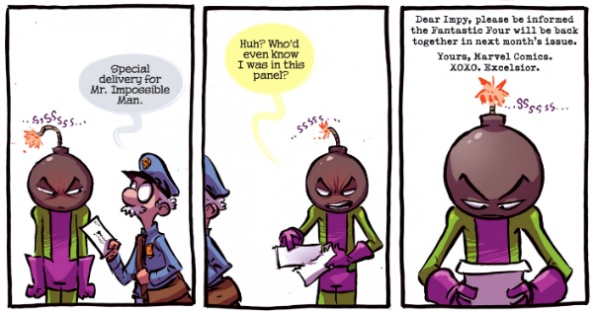
It’s a curious tactic, stopping just short of apologizing directly to the audience for the issue they’ve just read, rather than writing an issue that they would want instead. On the one hand, it’s nice to have our concerns recognized, but on the other, it seems a little odd for Slott to lampshade the faults in his own book, you know?

Anyway, as Impy says, we’ve waited this long, one more month won’t hurt! And as I pointed out in my review of “Fantastic Four” #1, the absence of Sue and Reed doesn’t detract from a promising start to the brand new series by Slott, Sara Pichelli, Elisabetta D’amico and Marte Gracia, and while yes, this does feel more like a prologue than an actual first issue, it’s at least an entertaining prologue.
We get to see just what Ben Grimm (aka the ever-lovin’ blue-eyed idol o’ millions, Sweet Aunt Petunia’s favorite nephew the Thing) and Johnny Storm (aka the Human Torch) have been up to since the team broke up (well, since the last issue of “Marvel Two-in-One” at least, but more on that later), as well as being reintroduced to longtime FF secondary characters Wyatt Wingfoot and Alicia Masters (more on her later, too).

We see the original signal flare, one not seen since the very first issue, and it’s actuation triggers very different reactions in Ben and Johnny. Thanks to recent issues of “Two-in-One,” we’re wise to the fact that Ben knows (or rather, “knows”) that Reed, Sue and the family are dead, so when he sees the flair, he knows that it can’t be his long-lost friends and family. Johnny, however, is the epitome of optimism here, literally flying off to the source of the signal, convinced his sister and brother-in-law (not to mention niece and nephew) are back and ready for the next wild adventure. It turns out to not be the first sign of the Richards family returning to Earth, life, and indeed life on Earth, but not to worry, as by issue’s end we see a real sign that the FF reunion we crave is right around the corner.
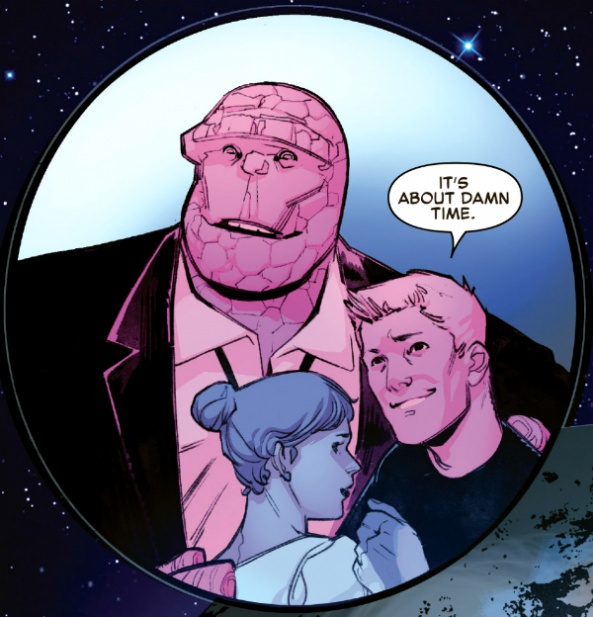
Along with this story and the Impossible Man strip, there’s also a Doctor Doom back up story, again written by Slott, with art by Simone Bianchi. While in the main story, Slott seems keen to take his time before restoring the status quo, here in this backup tale, Doom is almost frantically restored to his place as ruler of Latveria and back in his old, evil dictator costume. It all happens so fast that it risks undoing all of the development the character has gone through over the last few years, ever since the end of 2015’s “Secret Wars” in fact. Time will tell what Slott has planned for the iconic villain, but if we’re being completely honest here, this was bound to happen eventually, and besides, what would the Fantastic Four be without their primary nemesis?
Continued below
There’s a slight time gap between the events of the last issue of “Marvel Two-in-One” (#8) and “Fantastic Four” #1, but the last time we saw Ben and Johnny, the latter had just found out that his family was believed, by the former, to be dead. It seems that all of the optimism that was drained from him by that revelation is restored by the start of this issue, all for it to be taken from him once again by this issue’s end, only for it to yet again be fully restored on the final page. Look, Johnny’s been on a real roller-coaster of emotions, ok?

Over in “Marvel Two-in-One” #8, Ben and Johnny are trapped in an alternate universe by their former friend and eminent scientist Rachna Koul, who’s stolen the magical MacGuffin that will get them home. Presumably, they find their way back, as they seem relatively settled back in New York by the time “Fantastic Four” #1 opens (spoilers, I guess?).
It’s only when you read the debut issue of the FF that you realize just how much legwork Chip Zdarsky has put into developing the current relationship between Ben and Johnny. Slott does a great job of bringing you up to speed within this issue, but if you’ve been reading “Marvel Two-in-One,” where we’ve most recently seen a heartbreaking fight between the best friends tear down what little hope either of them had left of seeing their family again, you can really appreciate the emotional upheaval present in “Fantastic Four” #1.

It also adds a lot more weight to Ben’s decision to finally get down on one knee and propose to his long-time on-again, off-again love Alicia Masters. We’ve seen in “Two-in-One” just how much burden Ben had placed on his shoulders, suffering in silence over what he believed to be the grim truth about his adopted family, and lying about it to Johnny. Matchstick is more than just a friend to Ben, they’re brothers at this point, and despite their constant bickering, it’s never gotten as bad as seeing Johnny’s heartbreak over knowing that Ben kept such a potentially devastating secret from him. So, of course, when they get home and their relationship goes some way to being repaired (again, it’s a shame we haven’t seen that narrative beat just yet), Ben is going to do some serious evaluating about his life. And that soul-searching does what Ben’s soul always does: goes to Alicia.
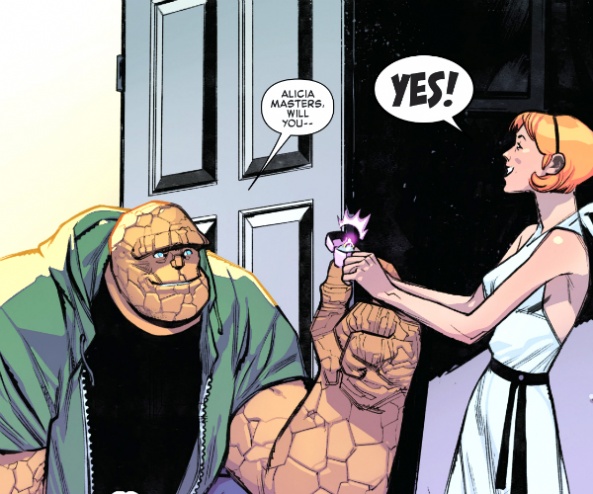
It’s been a long time coming, and aside from it being a positive sign that Dan Slott is eager to push characters within the Fantastic Four’s world forward, it’s also a positive step for Ben Grimm.
This isn’t the first time Ben has proposed to someone. Back during Mark Millar’s run on the title (“Fantastic Four” #562, to be exact), Ben proposed to his then-girlfriend, school teacher Debbie Green, a character introduced by Millar and who hasn’t been used since. That relationship ended when Ben didn’t show up to the wedding (ouch), only for Debbie to find him in a bar, where she’s told by Ben that he can’t go through with putting her in constant danger after seeing so many of his friends losing loved ones due to being a superhero.
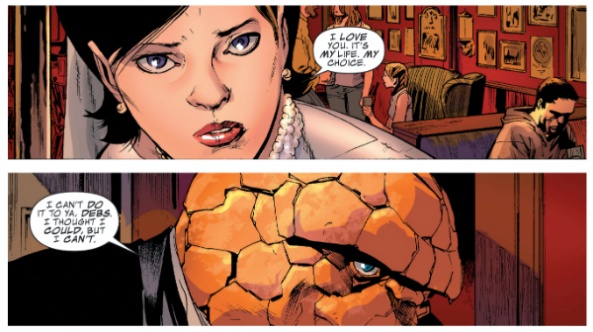
Well, he’s clearly changed his mind on that front, but to be fair Alicia has always been a part of the “Fantastic Four,” and is no stranger to the perils of the superhero lifestyle. First appearing in “Fantastic Four” #8 from 1962, Alicia is the stepdaughter of notable FF villain the Puppet Master, whose experiments with radioactive clay had made her blind in the first place.
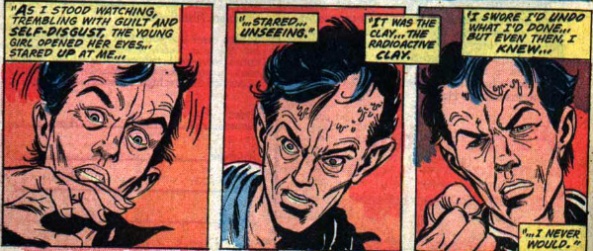
Since then, Alicia has been a frequent secondary character in the “Fantastic Four,” most commonly seen as a love interest of the Thing. As subtle as Stan Lee’s writing is known to be (read: not very), there’s something poetic about a blind sculptor being the only one who could truly see the beauty within a “monster” like Ben Grimm. I put monster in parentheses because tonnes of people see the beauty within Ben Grimm and know that he’s one of the best people within the Marvel universe, but I digress.
Continued below
Awkwardly, this isn’t the first time that Alicia has been engaged to a member of the Fantastic Four, and – surprise – it wasn’t Ben Grimm, but Johnny Storm! This one is going to take a little explaining, so bear with me. At the end of 1985’s event “Marvel Super Heroes Secret Wars,” Thing decided to remain behind on the alien Battleworld created by the Beyonder because there he was able to transform back into his human form at will.
After a while, he found that he couldn’t change back to being a human anymore and returned to Earth, where months had passed and in which time Alicia had found love with Ben’s teammate Johnny Storm. Devastated, Grimm did come to accept this new status quo, proclaiming that Johnny was more of a man than he was. Johnny and Alicia got married in “Fantastic Four” #300 (Ben was even the Best Man), but the celebrations were relatively short-lived.
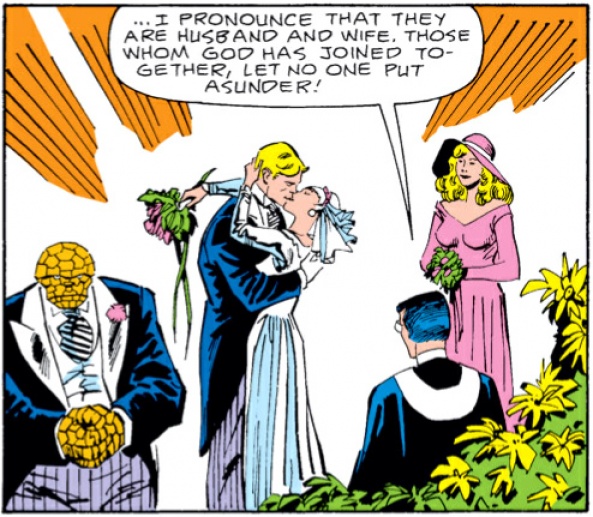
Here is where it gets confusing because it is revealed that the “Alicia” that Johnny had married was actually Lyja, a shapeshifting Skrull all along! Scandal! Lyja was a mole (in the spy sense, she didn’t transform into an actual mole as well) for the villain Paibok the Power Skrull, who had kidnapped Alicia and replaced her with Lyja. The FF did what they do best, of course, and defeated Paibok and returned Alicia to Earth. It turns out, however, that Alicia was kidnapped before Ben broke up with her, meaning that none of this complicated “I married your best friend” business ever happened to her after all, and she proclaimed that she still loved Ben.
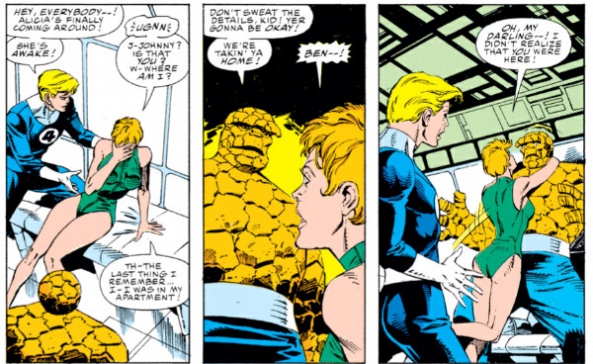
Realizing that this declaration didn’t make any of their situations any less awks, Alicia did what anyone would do, and jumped on the first silver surfboard off the planet to go exploring the cosmos with Norrin Radd. For a while, Alicia was the companion of the Silver Surfer in his own title (for nearly two years of real-time in fact), before returning to Earth and taking up residence as a babysitter for the FF’s kids, and the confidante and friend of the team, which is what she’s been ever since. Now you know a little bit more of the history of both Alicia and Ben, you can see why it’s taken so long for him to propose, and why it’s such a significant moment in the history of the Fantastic Four.
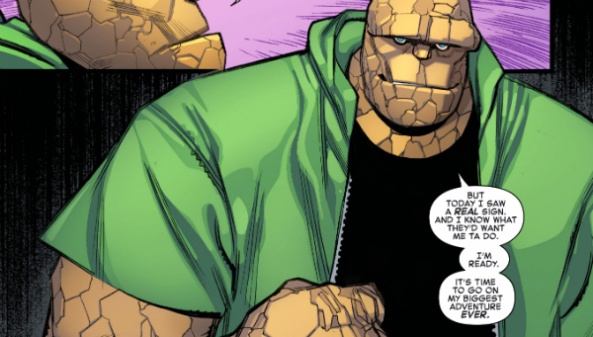
Speaking of the history of the “Fantastic Four,” let’s take a look at all the times we’ve seen a first issue from Marvel’s First Family. Surprisingly, there have been six “Fantastic Four” #1s since the very first one in 1961, including this latest one 57 years later. The original and most would argue the best was the seminal “Fantastic Four” #1, cover dated November 1961, and created by Stan Lee and Jack Kirby. This issue would not only kick off a creative partnership that would last through the first 100 or so issues of the FF, but would go on to create the foundational blocks of the modern Marvel universe as we know it, with titles such as “X-Men,” “Thor,” “The Incredible Hulk” and more.

As an issue, it’s a lot of fun. The cover is, of course, completely iconic, and while the story inside doesn’t light the world on fire (nor was it the best that Lee and Kirby could do when they worked together), there’s a lot of promise of the crazy adventures to come, and for its significance in comics history alone it’s a must-read.
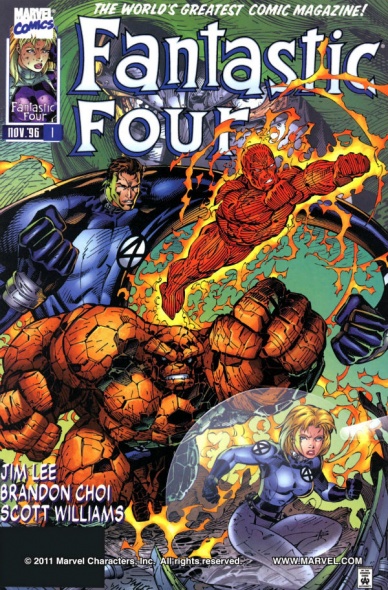
The next “Fantastic Four” #1 came a staggering 35 years later in November 1996, with the launch of the ‘Heroes Reborn’ initiative. Thanks to the might of the Omega-level mutant Onslaught (not to mention the bursting of the speculator’s bubble and the bankruptcy of Marvel Comics), the “Fantastic Four” was canceled at issue 416 and rebooted by Image Comics founder Jim Lee and Image writer Brandon Choi. In-universe, this reboot (which also affected the titles “Iron Man,” “Captain America” and “The Avengers”) was caused by Franklin Richards saving the lives of dozens of heroes who sacrificed themselves to defeat Onslaught, by placing them in a pocket dimension he kept in a red rubber ball.
Continued belowAs a reboot, this issue is naturally a more modern update to the first “Fantastic Four” issue 35 years earlier, albeit one with a grittier ‘90s edge. Full disclosure, my very first Marvel comic was the following issue of this series, “Fantastic Four” vol 2 #2, so you’ll forgive my nostalgic bias when I say that I look back on these issues with a particular fondness. Overall though, they’re not generally regarded as “good.”

When the Marvel heroes were restored to their rightful place in the Marvel universe (in the appropriately titled “Marvel Heroes Reborn: The Return”), all of the series that were rebooted were given yet another number 1. Keep in mind that this ‘Heroes Reborn’ experiment only lasted a year, making this the shortest gap between number 1 issues in superhero history at that time.

“Fantastic Four” vol 3 #1 didn’t need to deal with a reboot of the team, but thanks to the creative team of Scott Lobdell, Alan Davis, and Mark Farmer, this issue took a fresh new look at the status quo of the superhero family now they were back to their normal life. The story explored the nature of the team as a family and as adventurers, by pitting them against another group of individuals transformed due to a strange, unforeseen accident.
Thanks to a global corporation building somewhat carelessly on top of the ancient catacombs of Paris, a team uncovers a Lovecraftian temple deep underground, one that, when opened, unleashes a malevolent force that transforms them into The Ruined: four ancient beings with immense powers and a desire to drag the modern world back into their domain.
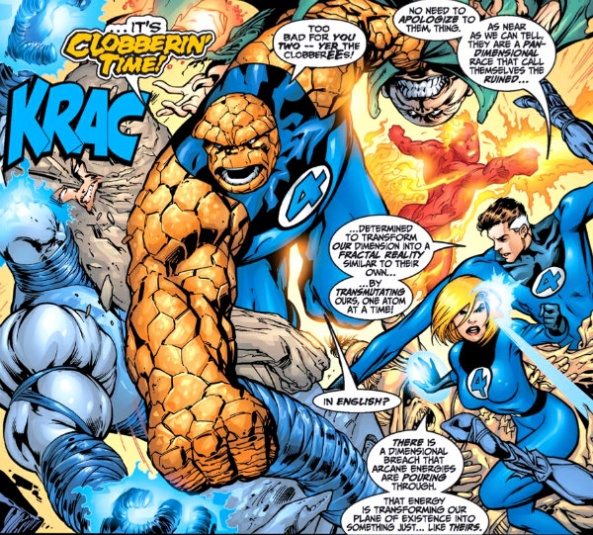
Davis and Farmer’s art is super dynamic, and along with Scott Lobdell’s fun script, this isn’t actually a bad first issue. It does a great job of re-establishing who the team is – both as individuals and more importantly as a family – and while the new villains aren’t that interesting (Chris Claremont uses them once more in his subsequent run on the title) they allow for the team to have an entertaining and satisfying return.
“Fantastic Four” would revert to its original numbering five years later, with #71 becoming #500. The series continued this way until 2008’s #588, which ended the book during Jonathan Hickman’s stellar run. Hickman’s story would continue in the brand new title “FF,” which (confusingly) continued on as a series even after the “Fantastic Four” book would return with #600 (including the “FF” series in its inflated numbering). “FF” ended at #23 and “Fantastic Four” ended at #611, both in 2012 thanks to the ‘Marvel Now!’ initiative.
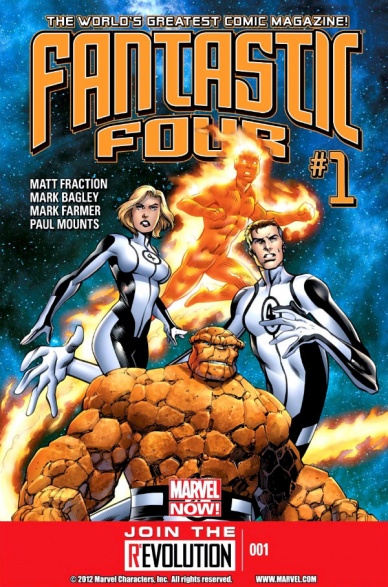
Writer Matt Fraction picked up the reigns of both “Fantastic Four” and “FF” at this time, weaving two interconnected stories over 32 issues (each series lasting 16 issues). In “Fantastic Four,” Reed took the family on a journey across time and space, while secretly looking for a cure to a disease that was stripping the team of their powers. In “FF” meanwhile, the substitute FF – consisting of Ant-Man (Scott Lang), Jennifer Walters (She-Hulk), Medusa and Darla Deering (Miss Thing) – were put in charge of looking after the Baxter Building while the real Fantastic Four were off exploring the cosmos.

Fraction’s run was severely underrated when it was released, and if you get the chance it’s worth reading both series all the way through. Fraction, unfortunately, has the rug pulled out from under him and gets the books canceled, meaning that we don’t get the conclusion he really wanted to give, but that’s a conversation for another time. “Fantastic Four” vol 4 #1, written by Fraction and with art by Mark Bagley, Mark Farmer, and Paul Mounts, is really strong. Fraction obviously has a lot of plans up his sleeve, and he wastes no time in re-establishing the team, laying out the driving points of the narrative and barely stops to breathe before whisking the team off into the universe and setting up the adventure moving forward.

Finally, the last number 1 before this latest issue was in 2014, when writer James Robinson had a brief run that lasted 18 issues, running from #1-14, then renumbered (again) to #642 until its conclusion in #645. Entitled “The Fall of the Fantastic Four,” Robinson’s run – accompanied by Leonard Kirk and Karl Kesel on art, colored by Jesus Aburtov, and lettered by Clayton Cowles – began with Susan writing a letter to Franklin and Valeria detailing just how broken her family had become. Reed was described as “a shell” of his former self, Ben was in prison for murder, Johnny described as a “lost soul,” and Sue herself heartbroken and alone.
Continued below
It’s a pretty bold start, and, much like Fraction’s run that came before, is surprisingly underrated. If you’ve not read this run, or gone back to it since its release, it’s surprisingly dark but never lets the seriousness of their situation bog the book down. After those grim revelations at the start of #1, for example, the action swiftly flashes back to recount just how they got into that state and cuts to the family fighting Fin Fang Foom, which is as “Fantastic Four” as it gets.
Sure, the FF had new, red uniforms which never really looked right (Robinson actually wrote the blue uniforms back into the story later in the run as this sort of cathartic moment for the team), but aside from that, the run was pretty good. It was clear that Robinson loved the history of the characters, as the issues were littered with various deep cuts from the FF’s long career, and by the end of the series, everything was back to normal and ended on a high.
Who would have thought it would be another three years before we’d see a new issue of “Fantastic Four?” It’s been a rough dry spell too, with an extremely bad movie, not to mention the rumors that Marvel was squashing the characters (and all related merchandising) due to Marvel Studios not owning the rights to the characters, but that’s all conversation for another time too. What’s important now is that the Fantastic Four are back! A brand new number one, a brand new creative team, and this brand new column to take you beyond what you see every month on the page!
Join us next month where we’ll be recapping “Marvel Two-in-One” #9 (out August 29th) and “Fantastic Four” #2 (out September 12th), as well as deep diving into more history of the team!
